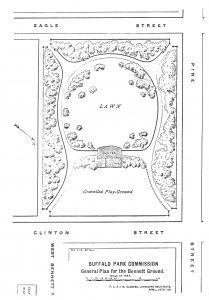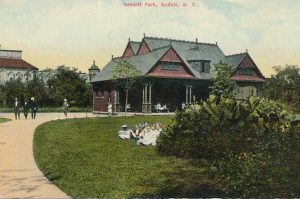Not all of Buffalo’s Olmsted park system preserves its beauty. Attention naturally centers on the six main parks of the system and their connecting parkways. Almost overlooked are Olmsted’s designs for smaller parks and grounds, one of which is Bennett Park, originally called Bennett Place.

In 1886 the control and care of all public squares and greens in the city was transferred to the Board of Park Commissioners. The following year, in 1887, Olmsted prepared landscape designs for four of the grounds for which the Board had assumed control: the two Terrace parks, Day’s Park, Masten Park and Bennett Park. In Allentown, Day’s Park, through the efforts of its neighbors, has been nurtured and maintained in its original beauty. Masten Park, on the west side of Masten Street between Best and North Streets, not long after its construction became the site of Fosdick-Masten High School, now City Honors High School. The Terrace parks, the Upper Terrace and the Lower Terrace, now lie beneath the ramps of the Skyway. Bennett Park, on the east side of Pine Street between Clinton and Eagle Streets, sits nearly unused. A pair of tennis courts and a few isolated park benches are all that hint that it is not simply a vacant lot marring a revitalized community with dozens of newly built homes.
Bennett Park was named for the property owner from whom it was acquired by the city. Olmsted’s design for the park called for entrances from each corner of the property, with flagstone walks encircling a lawn of horseshoe shape at its center, a shelter house facing toward Eagle Street, and a graveled play ground adjacent to Clinton Street. Thick plantings screened the park on from the streets, and helped conceal from the visitor that the site was relatively small.
The shelter house was constructed in 1888, and was designed by Henry L. Campbell of Buffalo, who was the architect for a number Buffalo park structures of the period. It was a brick gabled structure, trimmed in stone, with flagstone floors. It housed restroom facilities and a tool room, with a large covered space open on three sides to protect park visitors from the elements during inclement weather. A large storage area, the full size of the building, was provided under the gables. Bennett Park quickly became a very popular attraction, as it was located in a densely populated area of the city, and was quite distant from any other city park.

Beginning in 1916 the functions of the old Board of Park Commissioners were assumed by the city. Around 1920 a number of changes were made in the park. A softball diamond and tennis courts were built, and a new and more utilitarian shelter house built to replace the original. The graveled playground (rather rough on little knees) was removed. The plantings were considerably reduced, with lawn and floral display sharing the site with the new active recreation facilities. Its use as a quiet community gathering spot diminished. Eventually, it effectively became incorporated into the large John F. Kennedy recreation area built by the city to its north and west. Vandalism and neglect resulted in the demolition of the newer shelter. The two tennis courts within its boundaries lay unused until renovations in the 1990s restored them to use. Suggestions have been made to convert the space into entrance grounds for the adjacent school. Bennett Park has all but ceased to exist.
Is there is still a glimmer of hope that Bennett Park could become again the gem Olmsted intended? No expensive structures would have to be removed, no highways relocated. The original park plans are in the Olmsted archives. The adjacent recreation complex has space to house the tennis courts. The large number of newer homes built in the immediate area add a new dimension to the community Bennett Park serves. Within easy walking distance of the central downtown area, the original plan of Bennett Park envisioned it as a quiet beauty spot with plentiful benches and shady trees. Could the same outpouring of public sentiment and pressure which saved a smaller central city park of more recent design (Cathedral Park) from destruction bring Bennett Park back from the brink of extinction and add something remarkable to our Buffalo greenspace?